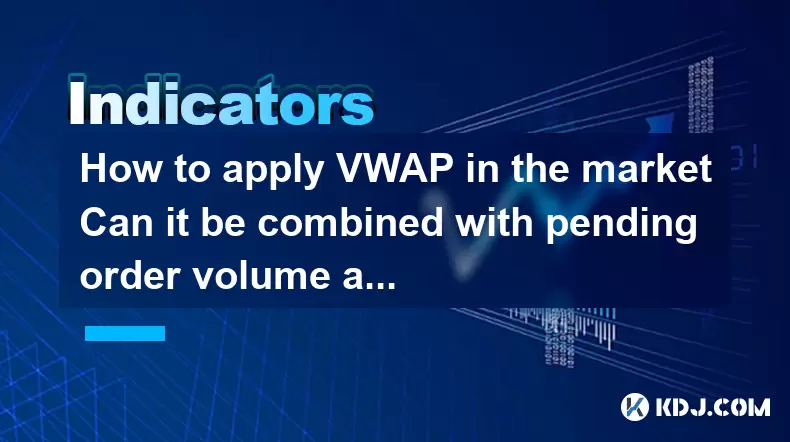-
 bitcoin
bitcoin $122288.232522 USD
0.16% -
 ethereum
ethereum $4480.662914 USD
-0.22% -
 xrp
xrp $2.962747 USD
-2.32% -
 tether
tether $1.000120 USD
-0.05% -
 bnb
bnb $1145.654223 USD
-2.07% -
 solana
solana $227.105217 USD
-1.67% -
 usd-coin
usd-coin $0.999548 USD
-0.02% -
 dogecoin
dogecoin $0.250875 USD
-2.04% -
 tron
tron $0.340654 USD
-0.49% -
 cardano
cardano $0.837968 USD
-2.52% -
 hyperliquid
hyperliquid $48.960449 USD
0.06% -
 chainlink
chainlink $22.049280 USD
-1.33% -
 ethena-usde
ethena-usde $1.000404 USD
0.02% -
 sui
sui $3.586212 USD
0.20% -
 avalanche
avalanche $29.894916 USD
-4.18%
How to apply VWAP in the market Can it be combined with pending order volume analysis
VWAP helps traders assess if they're buying or selling at favorable prices in crypto markets, and combining it with pending order volume analysis can enhance market insights.
May 21, 2025 at 09:49 pm

The Volume Weighted Average Price (VWAP) is a trading benchmark used by investors to gauge the average price a security has traded at throughout the day, based on both volume and price. It is particularly useful in the cryptocurrency market, where volatility can be high and trading volumes can significantly influence price movements. In this article, we will explore how to apply VWAP effectively in the cryptocurrency market and discuss its potential combination with pending order volume analysis.
Understanding VWAP in Cryptocurrency Trading
VWAP is calculated by taking the total dollar amount of all trading periods divided by the total trading volume for the same period. The formula is as follows:
[ \text{VWAP} = \frac{\sum (P_i \times V_i)}{\sum V_i} ]
Where (P_i) is the price of the trade and (V_i) is the volume of the trade for each period (i).
In the context of cryptocurrency trading, VWAP helps traders understand whether they are buying or selling at a favorable price compared to the market average. For instance, if the current price of Bitcoin is below the VWAP, it might be considered a good buying opportunity, whereas a price above the VWAP could indicate a selling opportunity.
Applying VWAP in Real-Time Trading
To apply VWAP effectively in the cryptocurrency market, traders need access to real-time data and a reliable trading platform. Here's how to use VWAP in your trading strategy:
- Choose a Time Frame: Decide on the time frame for your VWAP calculation. Common choices include intraday (e.g., 1-minute, 5-minute, or 1-hour intervals) or daily VWAP.
- Calculate VWAP: Use your trading platform's built-in tools or external software to calculate the VWAP. Most professional trading platforms will provide this functionality.
- Monitor the Price Relative to VWAP: Continuously monitor where the current price is in relation to the VWAP. If the price is below VWAP, it may be a good time to buy, and if it's above, it might be a good time to sell.
- Adjust Your Strategy: Based on the price movement relative to VWAP, adjust your trading strategy. For example, if the price consistently stays below VWAP, you might increase your position size in anticipation of a rebound.
Combining VWAP with Pending Order Volume Analysis
Pending order volume analysis involves examining the volume of buy and sell orders at different price levels. Combining this with VWAP can provide a more comprehensive view of market dynamics. Here's how to integrate these two analyses:
- Identify Key Price Levels: Use pending order volume analysis to identify key support and resistance levels. These are price points where a high volume of orders is concentrated.
- Compare with VWAP: Overlay the VWAP on your chart and compare it to the key price levels identified through pending order volume analysis. If the VWAP aligns closely with these levels, it can reinforce the significance of those price points.
- Analyze Market Sentiment: By combining VWAP and pending order volume, you can better gauge market sentiment. For instance, if the VWAP is rising and there is a high volume of buy orders at a certain level, it may indicate strong bullish sentiment.
- Make Informed Decisions: Use the combined insights to make more informed trading decisions. For example, if the VWAP is below a strong resistance level with significant pending buy orders, it might signal a potential breakout.
Practical Example of VWAP and Pending Order Volume Analysis
Let's consider a practical example using Bitcoin (BTC) to illustrate how to apply VWAP and combine it with pending order volume analysis.
- Scenario: You are monitoring the 1-hour VWAP for BTC/USD. The current VWAP is $40,000, and the current price is $39,500.
- Step 1: Identify key price levels using pending order volume analysis. You notice a significant volume of buy orders at $39,000 and sell orders at $41,000.
- Step 2: Compare the VWAP with these levels. The VWAP at $40,000 is between the key support at $39,000 and resistance at $41,000.
- Step 3: Analyze market sentiment. The VWAP is above the current price but below the resistance level, suggesting a potential upward movement if the price can break through the resistance.
- Step 4: Make a trading decision. You might decide to buy BTC at the current price of $39,500, anticipating a move towards the VWAP and possibly breaking through the resistance at $41,000.
Technical Considerations for Implementing VWAP and Pending Order Volume Analysis
To effectively implement VWAP and pending order volume analysis, traders need to consider several technical aspects:
- Real-Time Data: Ensure your trading platform provides real-time data for accurate VWAP calculations and up-to-date pending order volumes.
- Charting Tools: Use advanced charting tools that allow you to overlay VWAP on your price charts and visualize pending order volumes.
- Automation: Consider using automated trading systems that can calculate VWAP and monitor pending order volumes in real-time, allowing for quicker decision-making.
- Backtesting: Before applying these strategies in live trading, backtest them using historical data to understand their effectiveness and potential pitfalls.
Challenges and Limitations of Using VWAP and Pending Order Volume Analysis
While VWAP and pending order volume analysis can be powerful tools, they come with certain challenges and limitations:
- Volatility: The cryptocurrency market is highly volatile, which can lead to rapid changes in VWAP and pending order volumes, making it challenging to make timely decisions.
- Data Accuracy: The accuracy of VWAP and pending order volume data depends on the quality of the data feed from your trading platform. Inaccurate data can lead to flawed analyses.
- Market Manipulation: In the cryptocurrency market, there is a risk of market manipulation, which can distort both VWAP and pending order volumes, leading to misleading signals.
- Complexity: Combining VWAP with pending order volume analysis requires a good understanding of both concepts and the ability to interpret complex market data.
Frequently Asked Questions
Q1: Can VWAP be used for long-term trading strategies in the cryptocurrency market?A1: While VWAP is typically used for intraday trading, it can be adapted for longer time frames by calculating it over daily or weekly periods. However, for long-term strategies, other indicators like moving averages or trend lines might be more suitable due to the smoothing effect over longer periods.
Q2: How can I ensure the accuracy of VWAP calculations in the cryptocurrency market?A2: To ensure the accuracy of VWAP calculations, use a reputable trading platform that provides reliable real-time data. Cross-verify the VWAP with multiple sources if possible, and consider using software that can handle large datasets efficiently.
Q3: Are there any specific cryptocurrencies where VWAP and pending order volume analysis work best?A3: VWAP and pending order volume analysis can be applied to any cryptocurrency with sufficient trading volume. However, they are most effective with major cryptocurrencies like Bitcoin and Ethereum, where liquidity is high and data is more reliable.
Q4: Can VWAP and pending order volume analysis be used in automated trading systems?A4: Yes, both VWAP and pending order volume analysis can be integrated into automated trading systems. These systems can calculate VWAP in real-time and monitor pending order volumes, executing trades based on predefined rules and conditions.
Disclaimer:info@kdj.com
The information provided is not trading advice. kdj.com does not assume any responsibility for any investments made based on the information provided in this article. Cryptocurrencies are highly volatile and it is highly recommended that you invest with caution after thorough research!
If you believe that the content used on this website infringes your copyright, please contact us immediately (info@kdj.com) and we will delete it promptly.
- BlockDAG, DOGE, HYPE Sponsorship: Crypto Trends Shaping 2025
- 2025-10-01 00:25:13
- Deutsche Börse and Circle: A StableCoin Adoption Powerhouse in Europe
- 2025-10-01 00:25:13
- BlockDAG's Presale Buzz: Is It the Crypto to Watch in October 2025?
- 2025-10-01 00:30:13
- Bitcoin, Crypto, and IQ: When Genius Meets Digital Gold?
- 2025-10-01 00:30:13
- Stablecoins, American Innovation, and Wallet Tokens: The Next Frontier
- 2025-10-01 00:35:12
- NBU, Coins, and Crypto in Ukraine: A New Yorker's Take
- 2025-10-01 00:45:14
Related knowledge

What is a tower bottom candlestick pattern? Does it have a high success rate?
Sep 22,2025 at 07:18am
Tower Bottom Candlestick Pattern Explained1. The tower bottom candlestick pattern is a reversal formation that typically appears at the end of a downt...

What is a black hole pattern in the MACD indicator? Is it a cause for concern?
Sep 21,2025 at 06:54pm
Bitcoin's Role in Decentralized Finance1. Bitcoin remains the cornerstone of decentralized finance, serving as a benchmark for value and security acro...

How can I use the psychological line (PSY) to determine market sentiment?
Sep 17,2025 at 02:19pm
Understanding the Psychological Line (PSY) in Cryptocurrency TradingThe Psychological Line, commonly referred to as PSY, is a momentum oscillator used...

How can I determine if a double top pattern has officially formed?
Sep 21,2025 at 03:18am
Understanding the Structure of a Double Top Pattern1. A double top pattern consists of two distinct peaks that reach approximately the same price leve...

What is the Golden Valley pattern on the moving average? Is it better than the Silver Valley pattern?
Sep 21,2025 at 02:54pm
Understanding the Golden Valley Pattern in Moving Averages1. The Golden Valley pattern is a technical formation observed in cryptocurrency price chart...

What does a death cross of the RSI in the strong zone (above 50) mean?
Sep 17,2025 at 10:54pm
Understanding the Death Cross in RSI Context1. The term 'death cross' is traditionally associated with moving averages, where a short-term average cro...

What is a tower bottom candlestick pattern? Does it have a high success rate?
Sep 22,2025 at 07:18am
Tower Bottom Candlestick Pattern Explained1. The tower bottom candlestick pattern is a reversal formation that typically appears at the end of a downt...

What is a black hole pattern in the MACD indicator? Is it a cause for concern?
Sep 21,2025 at 06:54pm
Bitcoin's Role in Decentralized Finance1. Bitcoin remains the cornerstone of decentralized finance, serving as a benchmark for value and security acro...

How can I use the psychological line (PSY) to determine market sentiment?
Sep 17,2025 at 02:19pm
Understanding the Psychological Line (PSY) in Cryptocurrency TradingThe Psychological Line, commonly referred to as PSY, is a momentum oscillator used...

How can I determine if a double top pattern has officially formed?
Sep 21,2025 at 03:18am
Understanding the Structure of a Double Top Pattern1. A double top pattern consists of two distinct peaks that reach approximately the same price leve...

What is the Golden Valley pattern on the moving average? Is it better than the Silver Valley pattern?
Sep 21,2025 at 02:54pm
Understanding the Golden Valley Pattern in Moving Averages1. The Golden Valley pattern is a technical formation observed in cryptocurrency price chart...

What does a death cross of the RSI in the strong zone (above 50) mean?
Sep 17,2025 at 10:54pm
Understanding the Death Cross in RSI Context1. The term 'death cross' is traditionally associated with moving averages, where a short-term average cro...
See all articles










































































